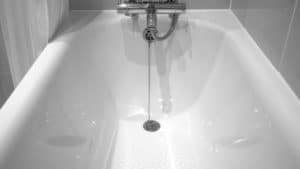Under the perfect finish of a bathroom, over the time, we may find unpleasant surprises. The fact that on the outside we see a beautiful and well executed tiling does not mean, necessarily, that a good installation work has been done. If it has not been done with a correct waterproofing, soon the moisture will start appearing.
Waterproofing the wet areas of bathrooms is no longer an option in the European Union: it has been compulsory for a long time. Something that fortunately, has brought great tranquility because is not always easy to detect water leaks, as it not only affecting the owners of the house but, also for their neighbors.

As a general rule, when a new bath or shower tray is installed in a new building, regardless of whether it is enameled or acrylic, resin or steel, concrete slabs or screeds come into play that, in both cases, are very porous materials and permeable to any small water leak. For this reason, the experience of an expert is essential.
Key points
Any good installer will have to prepare the support conveniently before waterproofing, for which it is necessary to eliminate any type of dirt -with a pressurized water wash- and an intense sweep. Among the materials that will be used are layers of flexible waterproofing mortar to mesh or fiberglass veils.
In the same sense, the installer must take into account key points at the time of proceeding to the waterproofing, which are susceptible to suffer small stresses and, therefore, where the waterproofing must be reinforced. Between these points they emphasize the corners (those points in which vertical elements converge) or the sink.
New regulations
Recently, a new regulation emerged, DIN 18534, which improves the regularization of the waterproofing of wet areas. The main novelty is that, for the first time, contemplates the waterproofing of floors and walls in combination with ceramics and natural stone, including the use of sheets and panels.
The DIN 18534 standard offers greater guarantees for consumers, given that the protections historically collected, now also requires new protections, such as the areas behind and below bathtubs and shower trays, thus reducing the risks of possible leaks of water. It is also important to keep in mind that outside of bathtubs and shower trays, there is also a stress caused by splashing water.
The methods to comply with the standard are diverse, from, simply, continuing the waterproofing behind and below the bathtubs or incorporate perimeter waterproof bands. However, it should be noted that it would not be enough just to seal the perimeter joints of the prefabricated elements with elastic mastics, but it is imperative to ensure the secure connection of all the components, connecting the edge band sealing tapes with those of surface of the wall.
For the seal, which must always be raised at least 5 centimeters above the top of the finished floor, materials such as polyethylene with geotextile on both sides are allowed. In this line, the direct use of the seal without a protective layer is considered as a special construction and is not regulated in this standard.
Undoubtedly, we are talking about good news, because this standard improves the quality of the work in the bathrooms so that, once the works are finished, you will enjoy this room over the years with the same comfort as the first day.







Leave A Comment